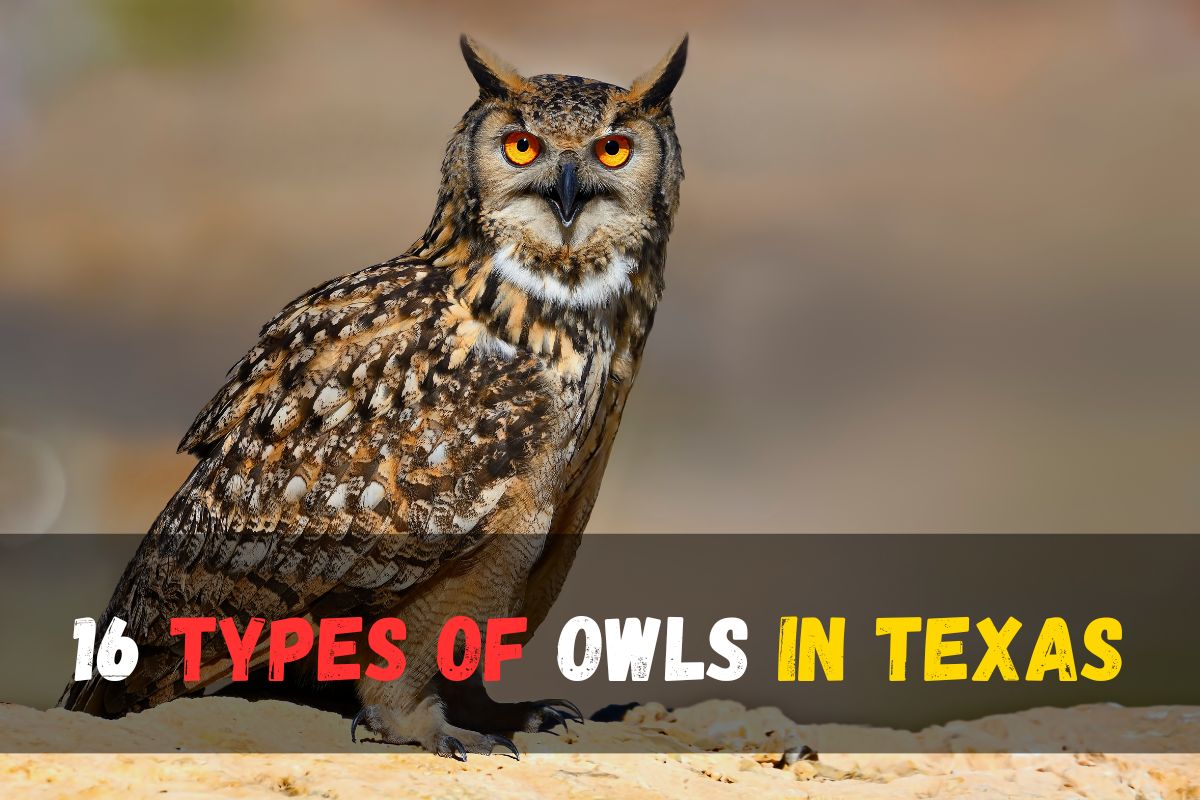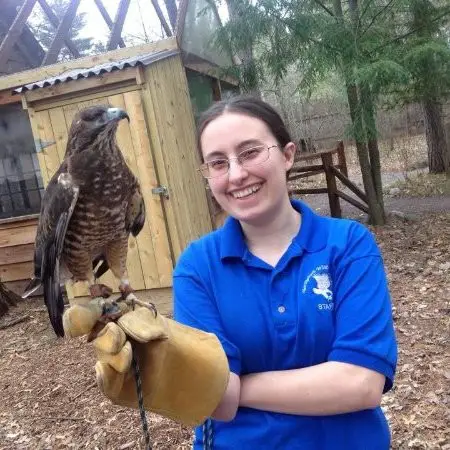Texas, the second-largest state in the United States, boasts a diverse ecosystem that is home to a variety of wildlife, including several species of owls. The Lone Star State’s diverse landscapes, ranging from expansive deserts to dense forests, provide an ideal habitat for these nocturnal birds of prey. Among the notable owl species found in Texas is the iconic Great Horned Owl, known for its distinctive ear tufts and formidable presence. These adaptable creatures can be found in a wide range of environments, from urban areas to rural farmlands.
8 Types of Owls in Georgia
The state’s commitment to conservation has played a crucial role in protecting owl populations and their habitats. Efforts by organizations and wildlife agencies, along with the support of local communities, have contributed to the preservation of Texas’ rich biodiversity. Additionally, the state’s various parks and nature reserves offer opportunities for birdwatchers and nature enthusiasts to catch a glimpse of these majestic birds in their natural surroundings. Texas, with its vast expanse and commitment to environmental stewardship, stands as a testament to the coexistence of urban development and the preservation of its unique wildlife, including the captivating owls that grace its skies.
Discover 3 amazing types of eagles in taxes
Types of owls in Texas
Short-eared Owl
Identification
The Short-Eared Owl (Asio flammeus) is a distinctive medium-sized owl species, easily recognized by its unique features. As the name suggests, it possesses short ear tufts, making them stand out among other owl species. With a round head, short neck, and a sandy belly, these owls exhibit characteristics that set them apart.
Their plumage is a mix of white, buff, and brown, featuring dark spotting on the uppersides and heavy brown streaking on the undersides. Notably, their underwings display pale coloring with evident dark barring on the wingtips and a distinctive dark comma near the “wrist.”
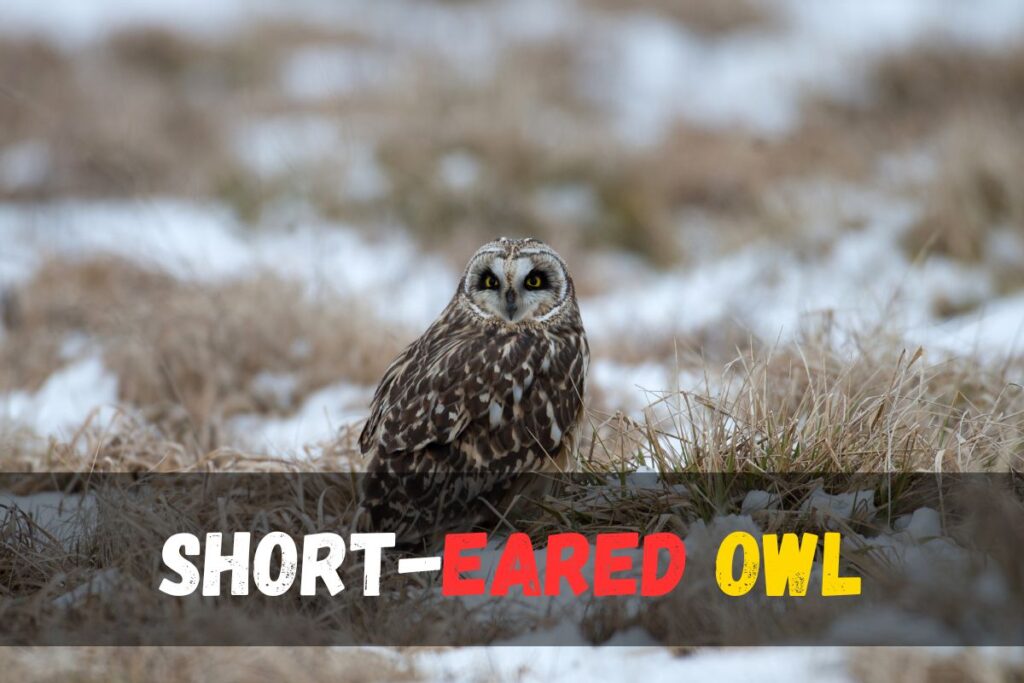
Where to Look for Them
Short-eared owls are winter visitors to Texas, primarily found in open areas such as meadows, grasslands, savannahs, shrubsteppe areas, marshes, agricultural lands, dunes, and tundra. While they can be scattered throughout the state, they are more commonly observed in northern Texas and along the Gulf of Mexico.
Prime Locations:
- Attwater Prairie Chicken National Wildlife Refuge – West of Houston
- Katy Prairie Conservancy – West Side of Houston
- Granger Lake Area – North of Austin
- Muleshoe National Wildlife Refuge – Near the New Mexico State Line
Appearance
The Short-Eared Owl has a medium-sized, pale brown, and buffy appearance, featuring very short ear tufts. Dark eye patches accentuate their pale faces, and their long wings exhibit buff patches near the wingtips. A lighter brown chest and belly, along with bright yellow eyes and pale feet tipped with razor-sharp black talons, complete their distinctive look.
Habitat
These owls prefer habitats such as meadows, grasslands, and large forest clearings. During the winter, they make their way into Texas, where they rest during the day in the safety of trees before taking to the skies at night in search of food. Their nests are typically found on the ground in dense vegetation, showcasing their adaptability to various landscapes.
Diet
Short-eared owls are opportunistic hunters, preying on a diverse range of animals. While their favorite prey includes voles and mice, they also feed on lemmings, rats, bats, shrews, pocket gophers, weasels, rabbits, shorebirds, gulls, terns, storm petrels, and songbirds. Their feeding habits make them a vital part of the ecosystem, contributing to pest control in their respective habitats.
Population
Despite being of “Least Concern” in terms of conservation status, the Short-Eared Owl faces challenges. Local declines have been noted in recent years, primarily due to habitat loss and fragmentation, particularly in grasslands. The overall population is estimated to be around 2.3 million breeding individuals, with fluctuations linked to prey cycles.
In Texas, their populations vary, with sightings more likely in winter. However, the species is sensitive to habitat changes, and conservation efforts should be directed toward preserving open and undeveloped areas crucial for their survival.
19 Types of Hawks in Texas
Great Horned Owl
Identification:
The Great Horned Owl, scientifically known as Bubo virginianus, is the largest owl species found in Texas. Recognizable by its distinctive ear tufts, this formidable bird boasts a wingspan of approximately 4.6 feet and a height of 2 feet. It is often distinguished by its hooting call, a characteristic sound that resonates in the fall and winter nights. The plumage varies, with a mottled gray-brown appearance, a white throat, and a rust-orange face. Notably, males and females appear similar, but females are generally larger.
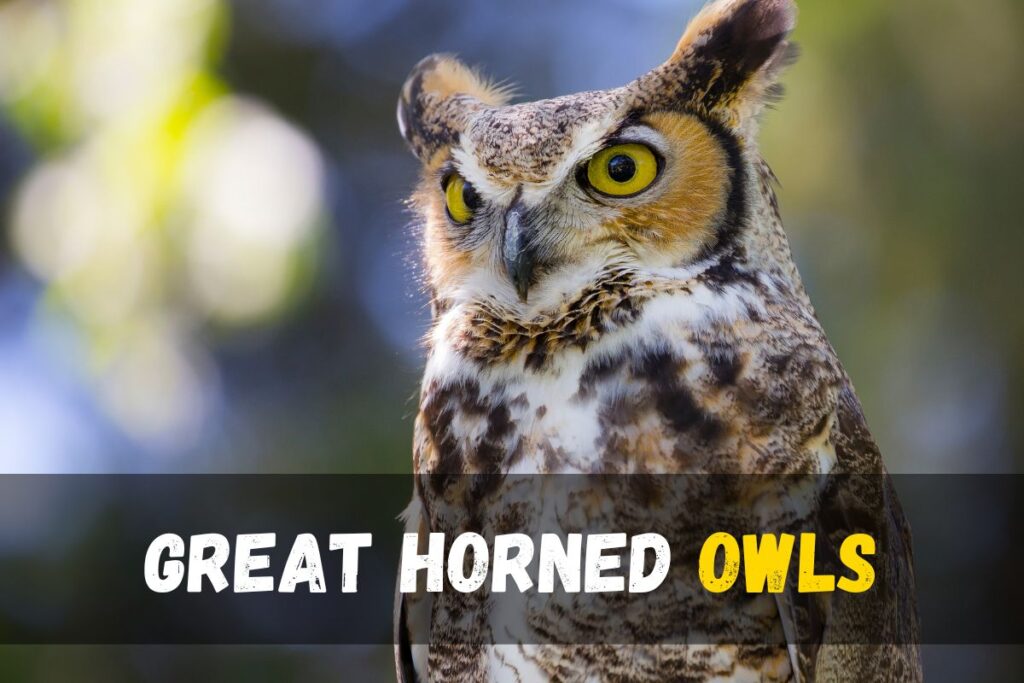
Where to Look for Them:
Great Horned Owls are versatile and can be found in various habitats across Texas. From woodlands and swamps to urban areas and city parks, these owls have adapted to diverse environments. They often perch on high tree branches or use abandoned nests, especially those previously occupied by large birds like hawks.
Appearance:
With their large yellow eyes and distinct ear tufts, Great Horned Owls are easily recognizable. Their massive size, coupled with a black beak and fine barring on the underparts, sets them apart. In terms of color, their plumage ranges from gray to brown, with variations across different regions.
Habitat:
The Great Horned Owl is a resident of Texas throughout the year, showcasing adaptability by thriving in a range of habitats. Preferred locations include woodlands, swamps, orchards, and agricultural areas. They also inhabit urban and suburban environments, demonstrating their ability to coexist with humans.
Diet:
Great Horned Owls are formidable predators with a diverse diet. They feed on mammals such as hares, mice, rabbits, and even larger birds. Additionally, their menu includes insects, reptiles, fish, and carrion. Their hunting strategy involves perching on high branches to spot prey in open habitats like grasslands.
Population:
The Great Horned Owl is classified as a species of “Least Concern” in terms of conservation. With an estimated population of approximately 5.7 million breeding birds, these owls demonstrate stability. However, they face threats from illegal hunting and the accumulation of pesticides in their systems due to consuming poisoned prey.
Barred Owl
Identification
The Barred Owl, scientifically known as Strix varia, is a distinctive species identified by its dark eyes, yellow beak, and unique lack of ear tufts. The buffy underside with horizontal barring on the chest and vertical streaks on the belly, coupled with brown and white mottling on the upperside, sets it apart. The call, resembling “Who cooks for you? Who cooks for you all?” further aids in identification.

Where to Look for Them
Barred Owls are predominantly found in Eastern Texas, with their range extending to Austin and San Antonio. They exhibit a preference for deciduous and evergreen forests, making these habitats ideal for bird watchers and enthusiasts. These birds tend to stay within a 10-mile radius and are more active during the night, roosting in trees during the day.
Appearance
Barred Owls have a distinct appearance with round, tuftless heads, almond-shaped eyes, and nearly black pupils. They are short-tailed, stocky, and feature a fluffy, heart-shaped face with checkered plumage. The wings, back, and tail display brown and white horizontal stripes, giving rise to their name “barred.”
Habitat
Their habitat choice centers around deciduous and evergreen forests, where they can find ample trees for roosting and nesting. Barred Owls have a preference for extensive, intact mature forests containing streams and swamps. Despite their range expanding to the Pacific Northwest, they generally stick to forested areas and do not migrate during their lives.
Diet
Barred Owls primarily feed on a varied diet, including small mammals (rabbits, chipmunks, squirrels, mice, voles), amphibians, reptiles, insects, fish, crustaceans, and birds. Their adaptable diet contributes to their successful population and low conservation concern status.
Population
The Barred Owl population is estimated at 3.5 million breeding individuals, showcasing an increasing trend of around 1.1% per year over the past five decades. Their range expansion, attributed to factors like boreal forest fire suppression and tree planting in the Great Plains, has contributed to their population growth.
Eastern Screech Owl
Identification
The Eastern Screech Owl, scientifically known as Megascops asio, is a fascinating owl species commonly found in Texas. Recognized by their grey plumage, small size (6 inches on average), and distinctive ear tufts, these owls also come in two color variations: grey morph and red morph. The yellow eyes and small stature make them easily distinguishable.

Where to Look for Them
These elusive creatures inhabit various environments in Texas, including woodlands, clearings, parks, and even suburbs. They prefer areas with tall trees for roosting and nesting, and some have been known to set up homes in parks and gardens.
Appearance
Eastern Screech Owls are small, with a wingspan ranging from 18.9 to 24 inches. Their nocturnal nature and excellent hiding abilities, blending into tree bark, make them more often heard than seen. The red morph, characterized by reddish-brown plumage, exists in northern Texas, while the grey morph dominates the species.
Habitat
While Eastern Screech Owls are primarily residents in the eastern half of the US, in Texas, they are widespread across the state, except for the very western strip. They adapt well to urban environments, utilizing nest boxes and varied nesting places.
Diet
These owls are night hunters with a diverse diet. They feed on small mammals such as mice, rats, squirrels, and rabbits, as well as birds like swallows, finches, and woodpeckers. Their prey also includes amphibians, reptiles, insects, and even small fish.
Population
Although the Eastern Screech Owl is considered a species of least concern, its population has declined by approximately 37% over the last five decades. The current estimate suggests around 560,000 breeding individuals.
Burrowing Owl
Identification
Burrowing Owls, scientifically known as Athene cunicularia, are distinctive among the owl species found in Texas. These small, long-legged owls boast a round head and are characterized by mottled brown coloring with bright yellow eyes. Notably, males and females look similar, with females being slightly larger. Young Burrowing Owls are uniformly dark brown and buff.
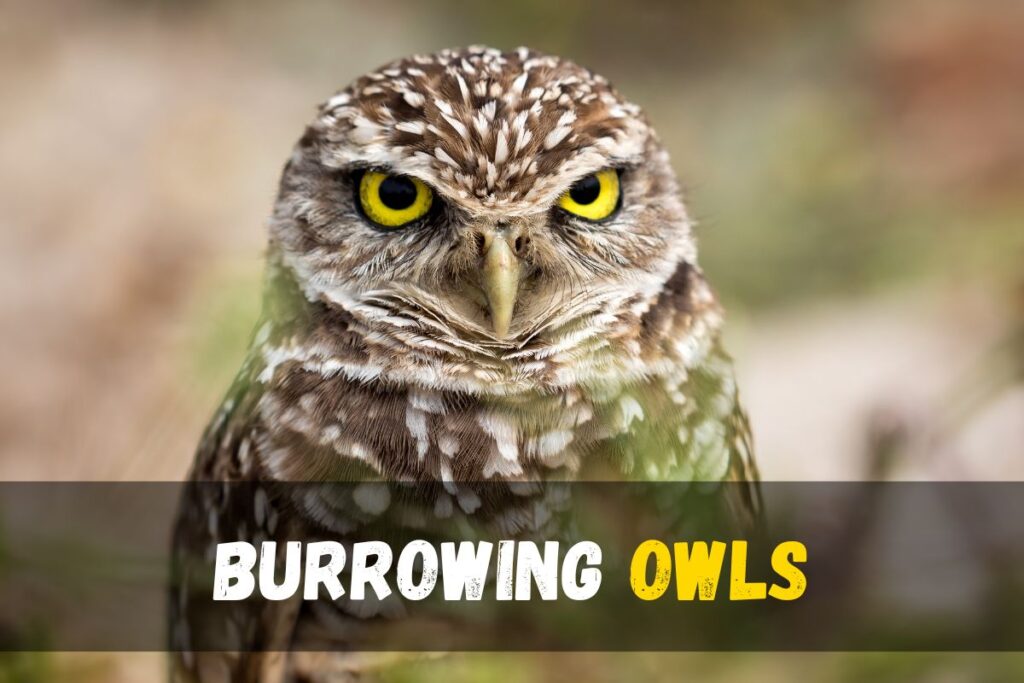
Where to Look Them
Burrowing Owls can be found throughout Texas, with a greater concentration in western and central regions. Meadows, fields, pastures, and areas with holes and subterranean dens serve as their preferred habitats. The Texas Panhandle area and Western Texas are particularly abundant in these owls, and they are active both during the day and night.
Appearance
These owls are relatively small, measuring around 10 inches in length, with an average wingspan of 22 inches. Their distinguishing features include pale underparts, dark brown and light gray dotted upperparts, a light brown head, and a pale face with two large yellow eyes. A defining characteristic is the long pale line above their eyes, resembling a prominent eyebrow.
Habitat
Burrowing Owls have adapted to various environments, including grasslands, prairies, steppe areas, deserts, agricultural lands, pastures, golf courses, airports, embankments, and suitable urban areas. They exhibit a unique nesting habit, utilizing burrows made by prairie dogs and other animals. Birds in Florida, however, have been observed creating their burrows.
Diet
The Burrowing Owl’s diet primarily consists of small rodents and insects. They are skilled hunters, employing both daytime and nighttime techniques for successful foraging. Insects such as grasshoppers, beetles, moths, and small mammals like shrews, mice, voles, and rabbits constitute their main sources of sustenance. This adaptable diet contributes to their widespread presence in diverse habitats.
Population
Despite being a relatively common species, the Burrowing Owl has faced challenges in certain regions. While not a species of immediate conservation concern, there has been a decline of around 4% per year in parts of the United States and 3.5% per year in Canada over the last five decades. Threats include habitat destruction, poisoning of burrowing mammals due to development and agriculture, as well as risks from domestic pets, vehicle collisions, illegal hunting, and pesticides.
Barn Owl
Identification
Barn Owls, scientifically known as Tyto alba, are distinguishable by their unique features. These medium-sized owls lack ear tufts and possess a whitish underpart, complemented by buffy-cinnamon and grey upper parts. Their defining characteristic is the heart-shaped face and dark eyes, making them one of the most visually striking owl species.
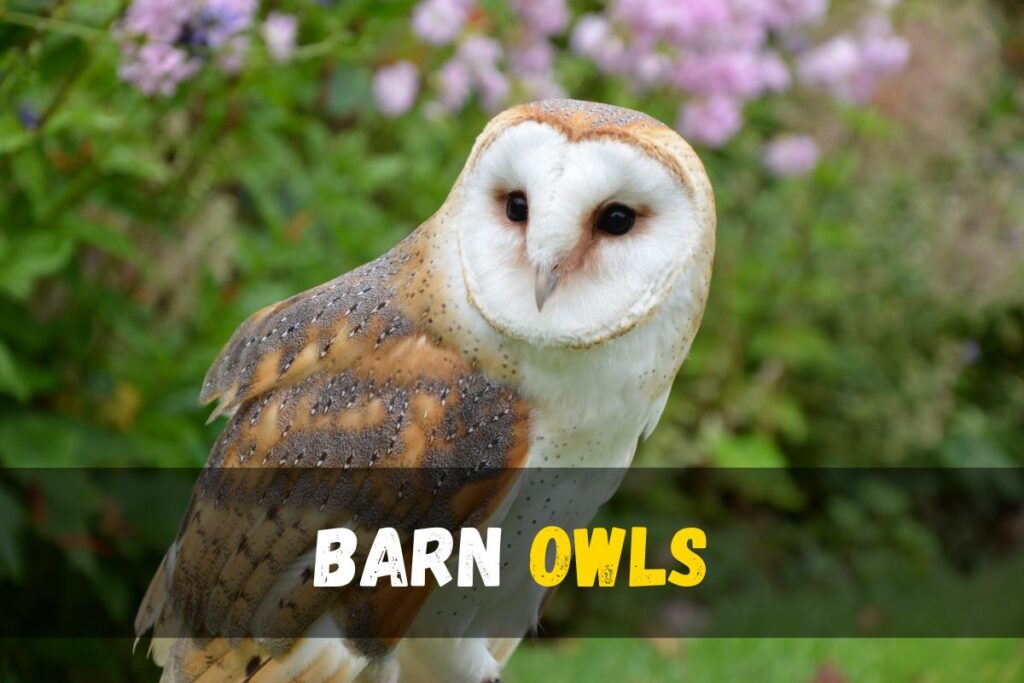
Where to Look for them
These fascinating creatures can be found year-round in Texas, predominantly in open habitats such as grasslands, fields, ranches, agricultural lands, and forest edges. They are adaptable and can nest in various locations, including tree cavities, church steeples, haylofts, and man-made structures like barns and attics.
Appearance
Barn Owls in Texas exhibit a large, pale stature with a wingspan ranging from 39.4 to 49.2 inches and a length of around 14 inches. Their silent flight, characterized by gliding and fluttering, adds to their mystique. The distinctive heart-shaped face and white underparts with black-bordered white dots on their wings make them easily recognizable.
Habitat Preferences
These owls are versatile in their habitat choices, inhabiting grasslands, fields, agricultural areas, and even suburban and urban environments. Their adaptability to both natural and man-made structures contributes to their widespread presence in Texas.
Dietary Habits
Barn Owls in Texas are skilled hunters, relying on their exceptional hearing to locate prey in complete darkness. Their diet primarily consists of small mammals such as rats, voles, bats, rabbits, and lemmings. Occasionally, they may also hunt small birds, lizards, and insects. Their nocturnal nature and keen night vision make them efficient predators.
Population and Conservation Status
Barn Owls are the most widespread land birds globally, with approximately thirty-five subspecies. In Texas, they are estimated to have a population of 3.6 million breeding individuals. Despite their prevalence, they face threats such as the transformation of agricultural areas and loss of nesting sites. DDT poisoning, previously impacting their rodent prey, has also posed challenges. However, their conservation status is relatively low, indicating a stable population over the past five decades.
Western Screech Owl
Introduction:
Western Screech Owls (Megascops kennicottii) are captivating nocturnal birds found in various regions of Texas. Known for their distinctive features and behaviors, these owls contribute to the rich biodiversity of the state.
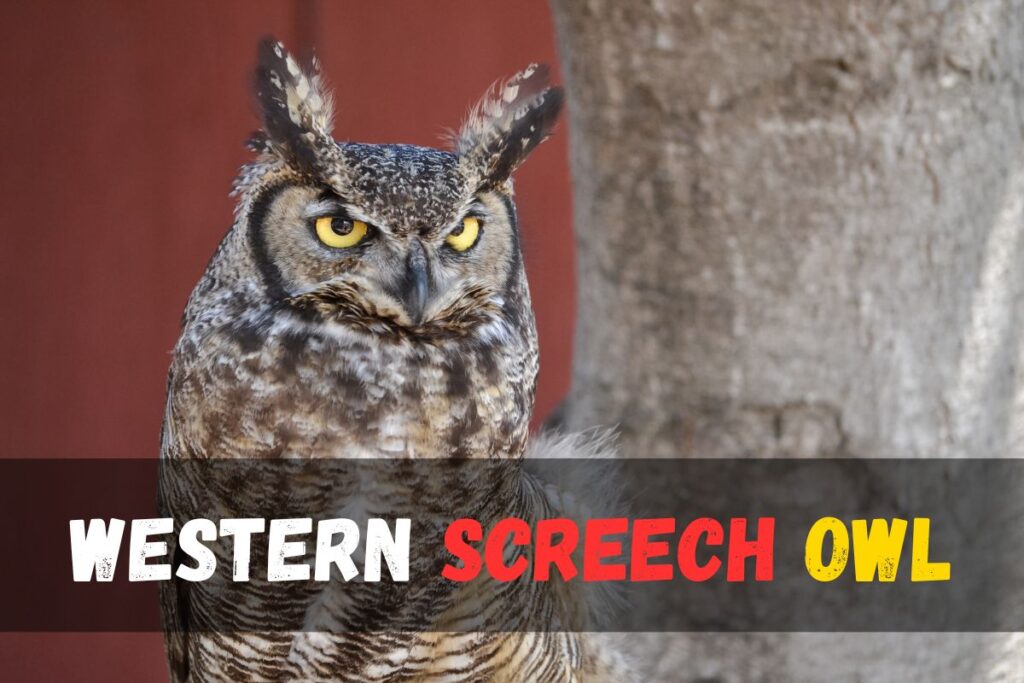
Identification:
Identifying Western Screech Owls involves recognizing key characteristics such as their scientific name, Megascops kennicottii, and their small, stocky appearance with tiny ear tufts. They exhibit two color morphs – brownish-red and grey, with the latter being predominant in Texas. The unique loud and screeching call sets them apart from other owl species.
Where to Look for Them:
These elusive owls can be found in a range of habitats, including forests, deciduous areas, mountains, coastal regions, parks, deserts, canyons, and even suburban locations. Notably, specific spots like Big Bend National Park, Big Bend Ranch State Park, and Davis Mountains Preserve provide favorable environments for observation.
Appearance:
Western Screech Owls showcase a round and stocky appearance, resembling their close relatives. Their size ranges from 7.5 to 9.8 inches, and they come in brown, grey, or reddish colors. The distinct V-shaped ear tufts and large, expressive yellow eyes contribute to their charming and easily recognizable features.
Habitat:
These adaptable birds make their homes in tree holes, cacti, and even nest boxes provided by humans. They are commonly found in suburban areas and urban parks. In Texas, their habitat extends to the western edge of the state and a small central area. Their preference for various environments, from dense woodlands to canyons, highlights their ability to adjust to different ecosystems.
Diet:
Western Screech Owls are efficient predators, mainly feeding on small mammals like mice, rats, shrews, bats, and rabbits. Their diet also includes birds, fish, amphibians, crustaceans, scorpions, snails, worms, and slugs. Despite their petite size, they are powerful enough to capture a full-grown rabbit.
Population:
The population of Western Screech Owls is estimated at 180,000 breeding individuals, categorizing them as a species of least concern. However, there are concerns about a potential decline, possibly influenced by the arrival of the Barred Owl and habitat alterations due to human activities. Conservation efforts are crucial to maintaining their population size and ensuring their continued presence in Texas.
Ferruginous Pygmy Owl
Identification
The Ferruginous Pygmy Owl (Scientific name: Glaucidium brasilianum) is a small owl species characterized by its compact size, measuring around 6.5 to 7.9 inches with an average wingspan of 15 inches. Its distinguishing features include a reddish-brown or gray plumage, streaked underparts, and two prominent black spots on the back of its round head. Males and females exhibit a comparable appearance, with females possessing a slightly larger size. Notably, this owl lacks ear tufts, and its call is a distinctive series of loud whistles.

Where to Look for Them
The Ferruginous Pygmy Owl is a rare resident in specific areas of southern Arizona and southern Texas. It prefers habitats such as dense woodlands, riverine woodlands, thorny thickets, and semi-open areas. In Texas, you might spot them in locations like the Norias Division of King Ranch, Lower Rio Grande Valley National Wildlife Refuge, and San Miguelito Ranch.
Appearance
This owl exhibits a captivating blend of dark orange feathers on its upperparts, wings, head, and breast. The underparts are mottled with the same dark orange hue, creating a striking contrast with pale white underlying feathers. Its small size and distinctive markings make it a unique and visually appealing species.
Habitat
The Ferruginous Pygmy Owl is well-adapted to desert and subtropical forest habitats. It nests in old cavities in trees or giant cacti, often utilizing abandoned spaces created by woodpeckers or naturally formed holes. Their preference for mesquite trees and saguaros in southern Arizona and Texas is notable.
Diet
Feeding primarily on insects such as caterpillars, crickets, and beetles, the Ferruginous Pygmy Owl also consumes small birds, scorpions, small mammals, and lizards. Their diet reflects their smaller size, and they are known to hunt at dawn or dusk, displaying aggressiveness uncommon for their stature. In times of scarcity, they may even prey on smaller songbirds.
Population
Despite being a species of least concern with a substantial population of around 50 million individuals, the Ferruginous Pygmy Owl faces threats like habitat destruction, fragmentation, and development. In South Texas, it is considered an uncommon, range-restricted species, and conservation efforts are crucial to ensuring its continued presence.
Flammulated Owl
Identification
The Flammulated Owl, scientifically known as Psiloscops flammeolus, is a petite owl with distinct features. Measuring between 5.9 to 6.7 inches and weighing 1.5 to 2.2 ounces, they boast a unique flammulated appearance, characterized by flame-like patterns on their feathers. Recognizable by their mottled gray and reddish-brown plumage, dark eyes, and short ear tufts, these owls are often mistaken for Screech Owls due to their similar appearance.
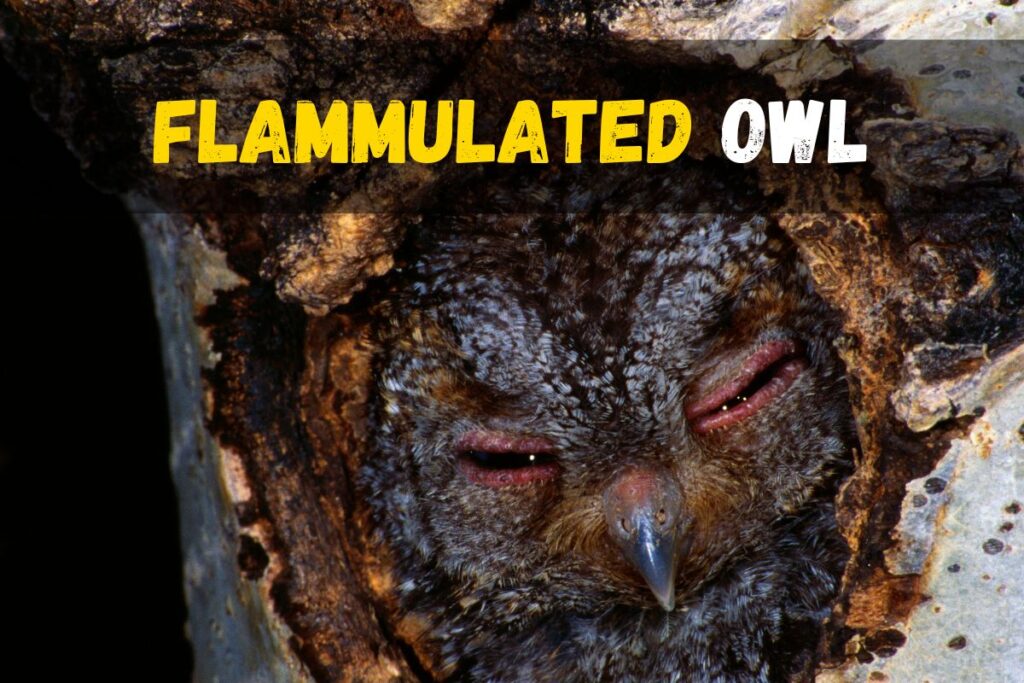
Where to Look for Them
Residing year-round in Texas, Flammulated Owls are primarily found in the western United States, with sporadic sightings in east and south Texas. Their elusive nature and excellent camouflage make them challenging to spot, especially during the daytime when they roost in coniferous forest treetops. Nighttime, with their low-pitched hooting calls, presents the best opportunity to locate them.
Appearance
The owl’s plumage, resembling the aftermath of a forest fire, incorporates blends of grays, blacks, and rust. Notably, their eyes are round and entirely black, contributing to their distinct look. Despite their small size, their hoots are surprisingly powerful and pitched low, owing to a larger windpipe, creating an impression of a larger bird.
Habitat
Flammulated Owls prefer mature mountain forests, particularly the tops of trees. They are cavity nesters, utilizing abandoned woodpecker nests or natural cavities for breeding. The montane forest habitats in Texas, consisting of tall coniferous trees like ponderosa pine and fir, interspersed with oak and Douglas-fir trees, serve as their ideal dwelling during the summer months.
Diet
These nocturnal hunters feed predominantly on insects, with moths, grasshoppers, crickets, beetles, and bugs being their preferred prey. Despite their small stature, they occasionally consume larger prey such as bats, mice, shrews, and birds. Their dark markings aid in nighttime hunting, making them nearly undetectable as they navigate through the air.
Population
The Flammulated Owl faces conservation concerns, with a dwindling population estimated at around 5,500 individuals. Threats include the loss of old forests due to logging, low reproduction rates, and pesticide exposure through contaminated prey. The species is categorized as “Least Concern,” but ongoing surveillance is crucial to monitor and address population declines.
Elf Owl
Identification:
The Elf Owl, scientifically known as Micrathene whitneyi, is a captivating species found in the arid landscapes of Texas. As the smallest North American owl, measuring a mere 6 inches, it boasts distinctive features. Recognizable by their round head, yellow eyes, and lack of ear tufts, Elf Owls showcase a v-shaped white stripe above their eyes. Their small size, comparable to a common sparrow, sets them apart in the avian world.
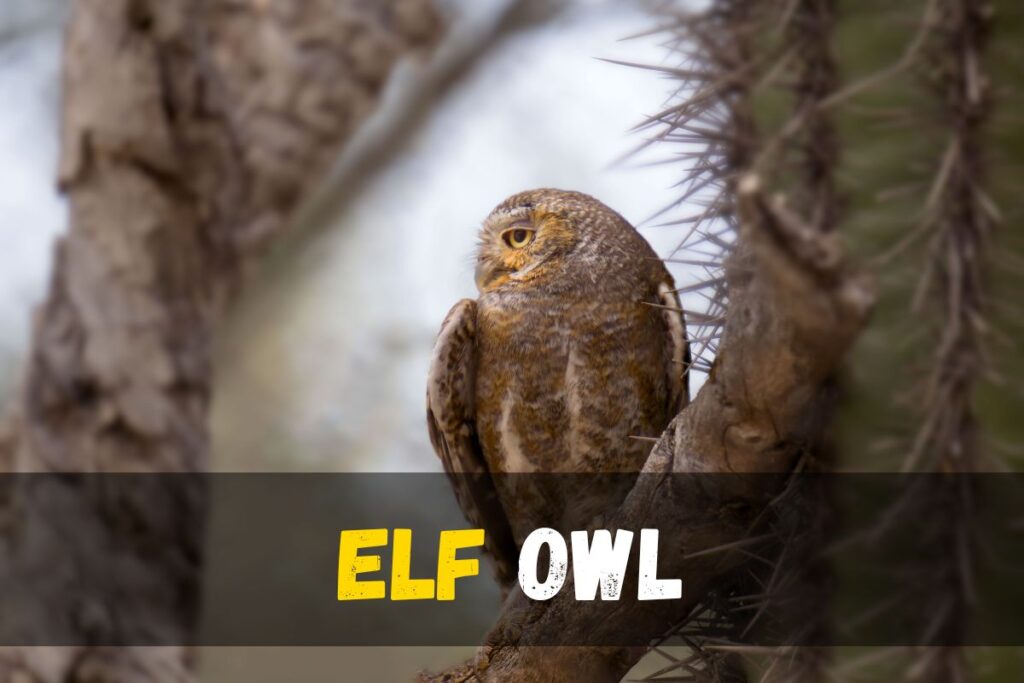
Where to Look for Them:
To spot Elf Owls in Texas, head to specific regions during the summer, primarily along the Mexican border. Notable locations include Bentsen-Rio Grande Valley State Park, Big Bend National Park, and Santa Ana National Wildlife Refuge. These areas, characterized by desert and woodland habitats, serve as temporary homes for these charming owls.
Appearance:
Elf Owls exhibit a soft gray and brown plumage with plain brown faces adorned with white eyebrows. Notably, both males and females share similar appearances, with females being slightly larger. The distinguishing feature is their petite size, making them a delightful sight for bird enthusiasts.
Habitat:
These owls thrive in diverse habitats, ranging from Saguaro deserts to wooded canyons, thorn forests, pine-oak forests, and well-wooded neighborhoods. They often nest in tree and cactus cavities, utilizing abandoned woodpecker holes in telephone poles, fence posts, and yucca stalks.
Diet:
Elf Owls have a specialized diet, primarily consisting of insects like moths, crickets, beetles, and even scorpions (after removing the stinger). During the winter, they migrate to Mexico to ensure a sufficient food supply. Their feeding habits encompass capturing prey in flight, on the ground, and within foliage.
Population:
While Elf Owls are considered a species of fairly low conservation concern, with approximately 72,000 individuals in their breeding population, there are notable threats. Habitat loss due to development, mining, overgrazing, and agriculture poses challenges. Despite their fairly common presence in Texas, the population is declining, emphasizing the need for conservation efforts.
Northern Saw-whet Owl
Identification
The Northern Saw-whet Owl (Aegolius acadicus) is a fascinating species, and its identification involves considering various distinctive features. Recognizing this small owl in Texas requires attention to key characteristics that set it apart from other owl species.
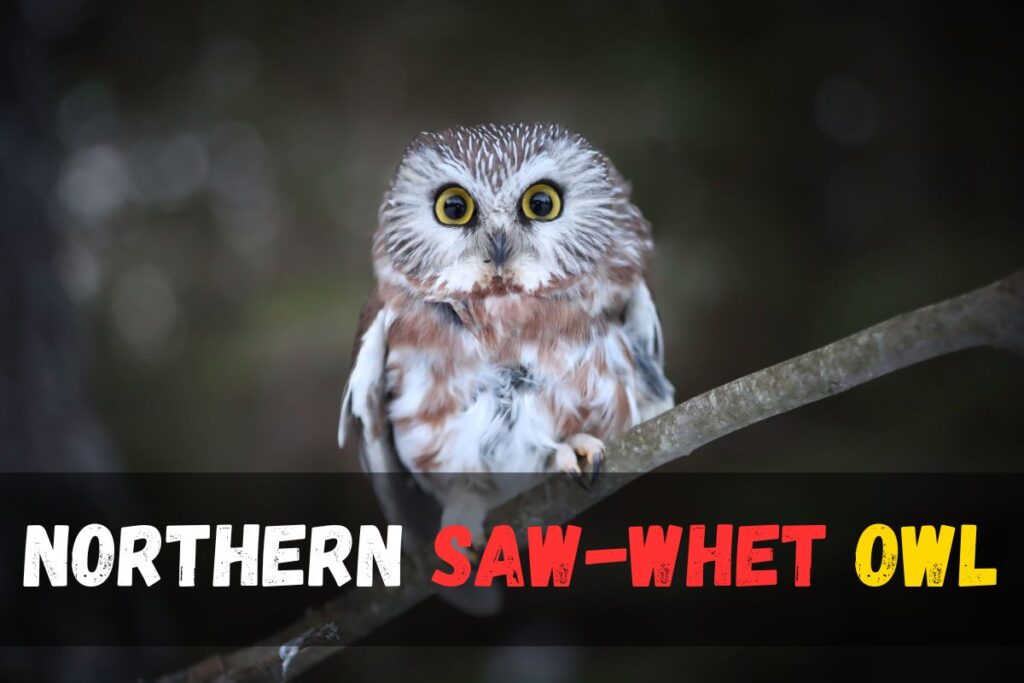
Physical Appearance
Measuring about 8 inches in length, the Northern Saw-whet Owl is comparable in size to a robin. Its dark brown plumage, adorned with white streaks on the underparts, gives it a distinctive appearance. The round head features broad white eyebrows, and a small, white V-mark between its bright yellow eyes contributes to its unique facial markings.
Juveniles have plain brown heads with visible white eyebrows on brown facial discs. Their underparts are a plain cinnamon brown, lacking spots on their backs.
Habitat and Where to Look for Them
These owls thrive in forested habitats, particularly mature coniferous and mixed hardwood forests. In Texas, they are rarely spotted outside the western edge of the state, and during the non-breeding season, their presence is even more sporadic. The Guadalupe Mountains National Park, including areas like The Bowl with high-elevation tree species, serves as a preferred habitat.
To catch a glimpse of these elusive creatures, one might explore the remote Tejas backcountry campground, accessible through a three to four-hour hike. Keep in mind that these owls are nocturnal, so nighttime excursions increase the likelihood of a sighting.
Diet
Northern Saw-whet Owls have a diverse diet, primarily consisting of small mammals like mice, shrews, voles, and juvenile squirrels. Their feeding habits also extend to birds such as kinglets, chickadees, sparrows, warblers, waxwings, and robins. Insects like grasshoppers and moths occasionally make it to their menu.
When seeking them out, consider their hunting patterns. They often swoop down at night to catch insects and small animals. In periods of food scarcity, they may resort to hunting small birds.
Population and Conservation
The Northern Saw-whet Owl boasts a breeding population estimated at around 2 million individuals, earning it a status of “Least Concern” in terms of conservation. Despite facing threats like habitat loss due to logging and development, these owls show adaptability by accepting nest boxes. The decline in nesting sites can be mitigated through this conservation-friendly approach.
While the permanent population exists in the northern part of the United States and throughout the Rocky Mountains and western Coastal ranges, breeding populations in the South are scarce. In Texas, their year-round presence is confined to a small section of the western edge, with occasional appearances in the rest of the state during the non-breeding season.
Long-eared Owl
Identification
The Long-Eared Owl (Scientific name: Asio otus) is a distinctive medium-sized owl species found in Texas. Recognizable by its long ear tufts, orange facial discs, and slender body, this nocturnal hunter stands out in the owl family. Distinguished by their hoots, meows, and occasional barks, Long-Eared Owls communicate through a series of low sounds, making them easily identifiable during the night.
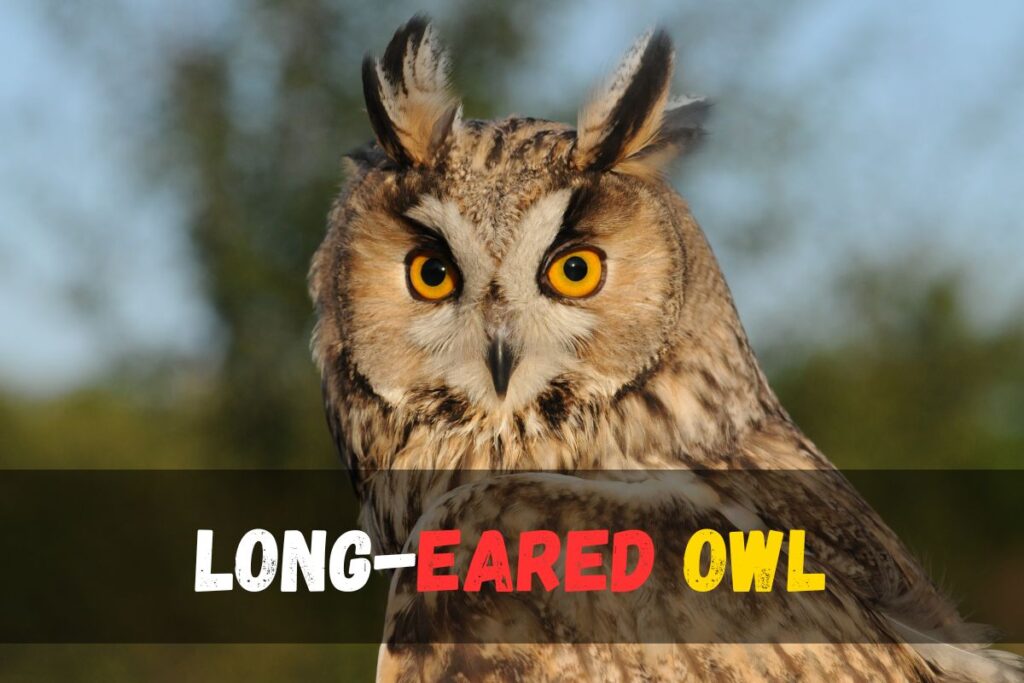
Where to Look for Them
Long-eared owls are more frequently observed in the western part of Texas, particularly in areas like Amarillo and El Paso. During the winter months, they might be spotted in eastern Texas but less frequently. Their preference for pine woodlands, open areas near meadows, and grasslands makes these habitats ideal for sightings. Listen for their distinctive calls, a low “hoo,” evenly spaced every few seconds, to locate them.
Appearance
Measuring around 14 inches in length with an average wingspan of 38 inches, Long-Eared Owls have a mottled grayish-brown body covered in dark brown and orange markings. Their most striking feature is the long ear tufts, jet black and bordered with rust-orange plumage. These owls also have a rough, rust-orange colored face with yellow eyes and two white lines between them. Male and female Long-Eared Owls look similar, but females are larger.
Habitat
Long-eared owls prefer coniferous woodlands, where they often perch near the trunk. They utilize abandoned nests from other bird species for shelter and resting during the day. Their migratory patterns lead them to spend winter in Texas, especially in pine stands near pasture or grassland areas. Lubbock, Big Bend National Park, and Dallas are some regions where sightings have been reported.
Diet
These owls predominantly consume small mammals, including mice, voles, rats, shrews, rabbits, and pocket gophers. Additionally, they consume small birds, snakes, and lizards on occasion. Long-eared owls are known for their silent flight, soaring close to the ground to hunt with sharp claws. Their hunting behavior contributes to their survival in diverse habitats.
Population
Long-eared owls are a species of low conservation concern, with a population size estimated at 520,000 breeding individuals. However, there are concerns about a declining population due to factors like habitat loss and disturbance. While they may not breed in Texas, their presence during winter suggests a migratory pattern that brings them to specific regions, offering opportunities for observation.
Spotted Owl
Identification:
The Spotted Owl, scientifically known as Strix occidentalis, is a distinctive species characterized by its dusky-chestnut brown color, adorned with white spots on the abdomen, head, and back. Notably, it possesses all-black eyes, a heart-shaped light gray face, and a large size, measuring 1.5 feet in length with an impressive wingspan of 4 feet.
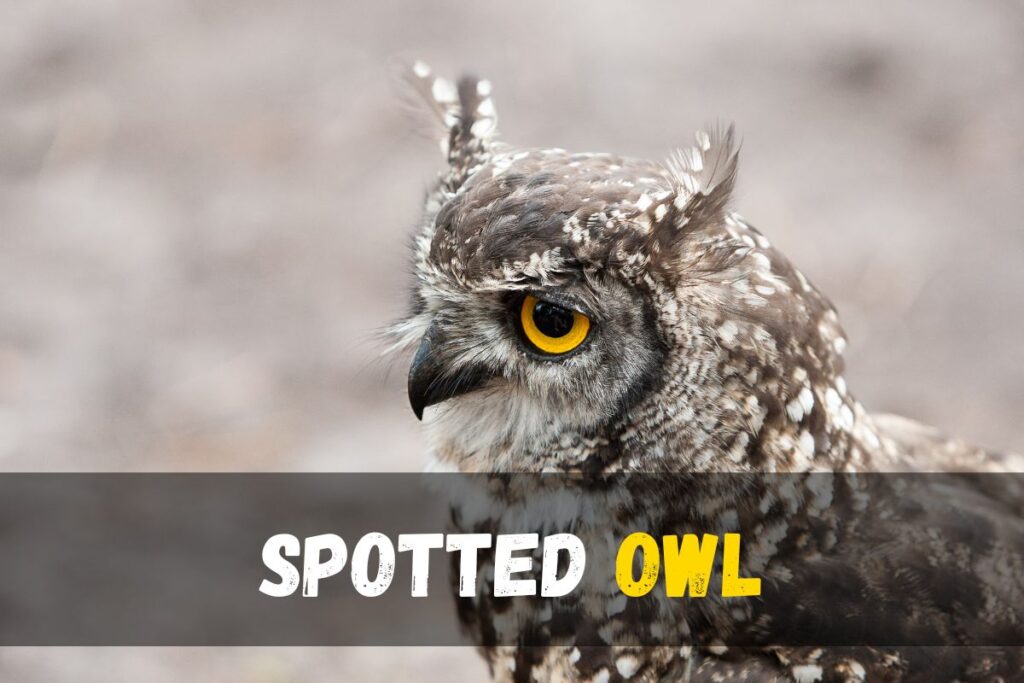
Where to Look for Them:
Spotted Owls are primarily found in the western forested regions of Texas, specifically in old, mature, and dense forests with a significant canopy cover. Their preferred habitats include elevations up to 7,000 feet, making them limited to specific areas like Guadalupe Mountains National Park and the Davis Mountains Preserve.
Appearance:
The Spotted Owl’s unique features include a dark brown body with prominent white spots, with more spotting on the chest and less on the back and wings. Its facial disks are defined with a dark border, white eyebrows, and whiskers. The distinguishing factor from the Barred Owl is the horizontal lines on the Spotted Owl’s body.
Habitat:
These owls favor habitats with old, large trees, making them particularly vulnerable to habitat loss from timber logging. Deforestation, human expansion, and competition with the Barred Owl have led to their decline. They are specially adapted to pine-oak or mixed conifer forests, including pine, Douglas-fir, or fir trees.
Diet:
Spotted Owls are nocturnal hunters, preying on small to medium-sized creatures such as flying squirrels, woodrats, mice, voles, rabbits, hares, bats, and pocket gophers. They also target insects, small birds, and amphibians. The Spotted Owl’s remarkable night vision aids in hunting a diverse menu, including bats, reptiles, and small birds.
Population:
The Spotted Owl faces significant conservation concerns with a declining population, estimated at 15,000 breeding individuals. The main contributors to this decline are habitat loss due to deforestation, habitat degradation, human expansion, and competition with the Barred Owl. As a result, the Spotted Owl is classified as a near-threatened species.
Snowy Owl
Introduction:
Snowy Owls, a captivating species native to the Arctic tundra, are a rare but remarkable sight in Texas. While they typically thrive in the icy landscapes of the far North, occasionally, these majestic birds venture into the Lone Star State, creating a stir among bird enthusiasts.

Identification:
Distinguished by their immense size, Snowy Owls stand at over 2 feet tall, boasting an impressive wingspan of 4-5 feet. Their predominantly white plumage, occasionally barred with brown or black, sets them apart. Females and juveniles exhibit more extensive dark markings, especially on their backs and wings. Bright yellow eyes, round heads, and a silent demeanor characterize these iconic birds.
Where to Look for Them:
Snowy Owls are not permanent residents in Texas, but during extraordinary events, known as irruptions, they may grace the state. The Winter of 2017 – 2018 witnessed an unprecedented influx of Snowy Owls in Texas, with sightings reported in Fort Worth, Odessa, Amarillo, Gruver, and Pottsboro. To spot them, keep a vigilant eye on reports during winter and be ready to chase down these magnificent creatures when they make a southern push.
Appearance:
The Snowy Owl’s appearance is synonymous with elegance. Males are generally mostly white, while females and young birds showcase intricate black barring. Their keen adaptation to the Arctic is evident in their feather-covered legs and feet, protecting them from the harsh cold. During winter, their white markings serve as perfect camouflage in the snowy surroundings.
Habitat:
Snowy Owls thrive in cold climates and are typically found in the Arctic tundra. In Texas, they may be spotted in open areas resembling their Arctic habitat, such as coastal dunes, lakeshores, prairies, and shrubby environments. Their preference for vantage points like hummocks and ridges allows them to keep a watchful eye on their surroundings.
Diet:
While known for their size, Snowy Owls are not particularly vocal. They primarily make noise when threatened. In terms of diet, their preferred fare includes lemmings, but they are not picky eaters, also consuming rabbits, fish, rodents, and smaller birds. Their larger size enables them to hunt larger prey, such as rabbits and lemmings.
Population:
Snowy Owls are not permanent residents in Texas, and their population is largely dictated by irregular irruptions. The frequency of Snowy Owl sightings in Texas is sporadic, with notable instances like the unprecedented 2017 – 2018 outbreak. Monitoring reports during winter can offer opportunities to witness these captivating birds during their temporary stay in the state.
Stygian Owl
Introduction:
The Stygian Owl, a fascinating species, is a medium-sized, blackish owl found in various parts of Mexico, the Caribbean, and South America. Although a rare vagrant, it has been spotted in southern Texas.
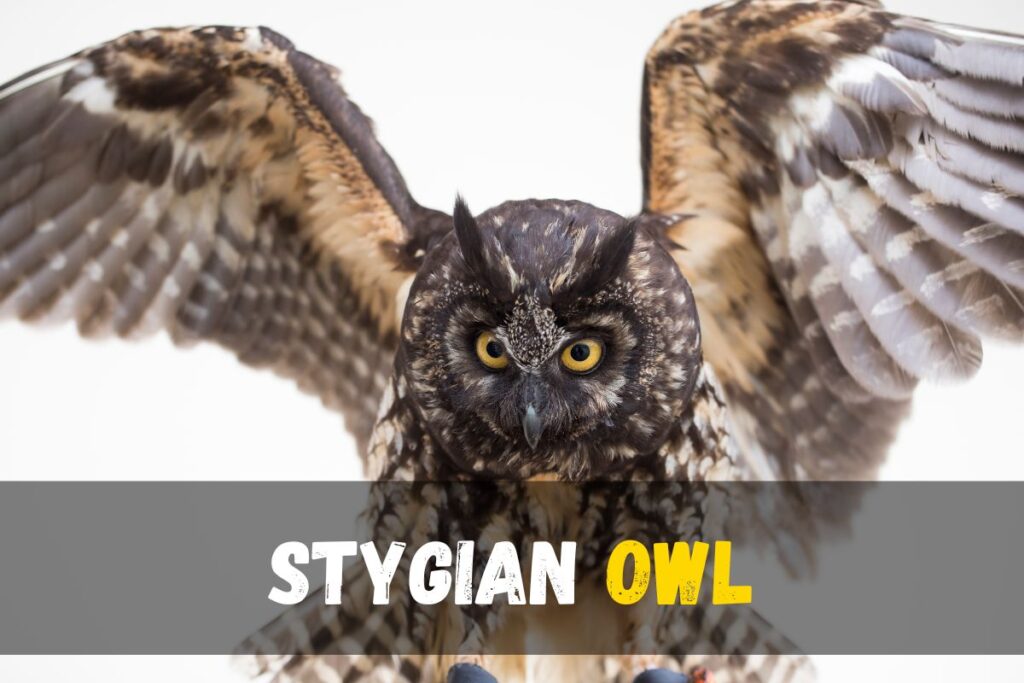
Identification:
This unique owl is large and slender, sporting distinctive ear tufts and yellow eyes. Its forehead carries a white mark, complementing its blackish face. Notably, it exhibits dark streaks and barring on pale underparts, with females being slightly larger. The buff on its belly, along with large feet and long talons, adds to its distinctive features.
Where to Look for Them:
The Stygian Owl is a tropical species, favoring coniferous and semi-open woodlands. It has been observed in various tropical woodland habitats, making it a captivating find for birdwatchers.
Appearance:
Measuring 16.5 inches with a wingspan of 38 inches, this owl captivates with its elegant yet mysterious presence. The high-pitched and deep hoot calls further contribute to its allure. Males and females share a similar appearance, but the slight size difference can aid in identification.
Habitat:
Adaptable to diverse environments, the Stygian Owl can be a permanent resident or a rare vagrant. It thrives in tropical woodland habitats, showcasing its versatility. Interestingly, it can nest on the ground or repurpose old raptor nests, reflecting its resourcefulness.
Diet:
The Stygian Owl is a nocturnal hunter, preferring to watch from a perch before swiftly flying to catch roosting birds and other small animals at night. This behavior is key to its survival and reflects its role in maintaining the balance of the ecosystem.
Population:
While not extensively studied, the Stygian Owl’s population status remains a subject of interest. As a vagrant owl, its sightings in southern Texas add a layer of mystery, prompting further exploration and conservation efforts to understand and protect this species.
Mottled Owl
Introduction:
In the realm of avian diversity, Texas holds a remarkable distinction – hosting the documentation of the rarest owl ever spotted within its borders. This extraordinary find, technically a Mottled Owl, emerged in 1983 when a passerby discovered the lifeless creature on the side of a road near Bentsen Rio Grande State Park, just north of the Mexico border.
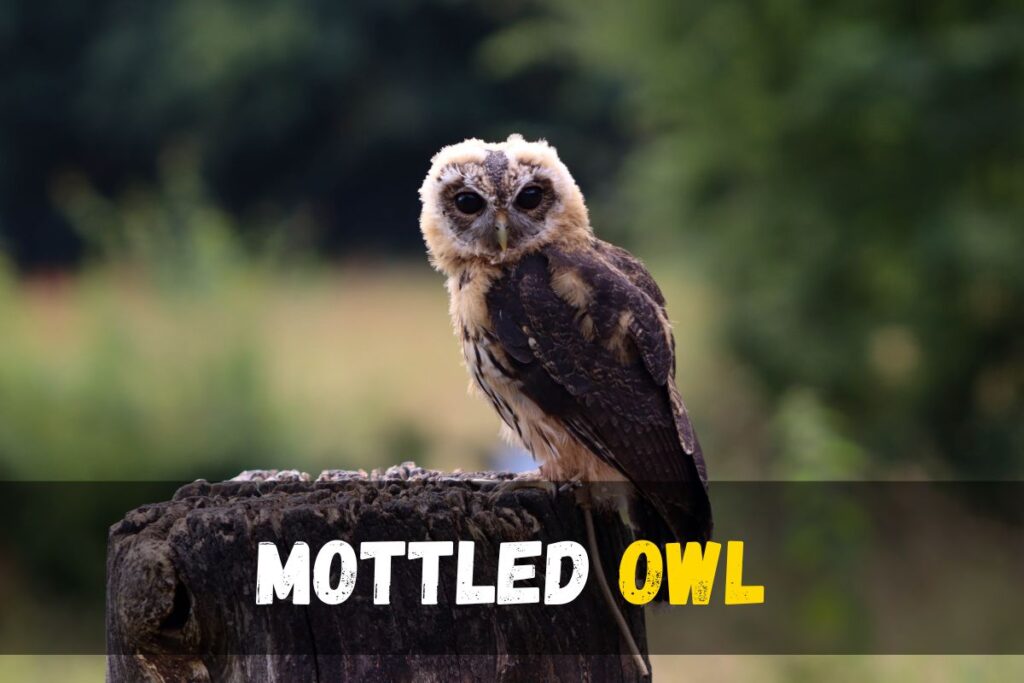
Identification:
The Mottled Owl, a small to medium-sized owl, features distinctive characteristics, including a round head, dark eyes, and a yellowish beak. Its dark brown plumage, accompanied by pale eyebrows and buff underparts adorned with dark streaks, sets it apart. Notably, both male and female Mottled Owls share these traits, with females being larger and exhibiting broad wings and pale bands on a medium-length tail.
Where to Look for Them:
This rare species is known to occur as a vagrant in the southern reaches of Texas, particularly in the lower Rio Grande Valley. If one aspires to spot this elusive creature, keeping an eye on tropical forest patches and various woodland habitats during nocturnal hours may yield success.
Appearance:
The Mottled Owl’s appearance is characterized by its small to medium size, round head, and dark brown plumage. Dark eyes and pale eyebrows add to its distinctive features, making it a captivating sight for bird enthusiasts. The male and female Mottled Owls look alike, but the females are noticeably larger, with broad wings and pale bands on their tails.
Habitat:
This nocturnal owl prefers dwelling in tropical forest patches and other woodland habitats. It seeks refuge in natural tree cavities and is adaptable enough to use nest boxes for nesting purposes. This adaptability contributes to its survival in diverse environments.
Diet:
The Mottled Owl employs a strategic hunting technique, often perching to survey its surroundings before swooping down to catch small animals on the ground, primarily at night. This behavior aligns with its role as a nocturnal predator in the ecosystems it inhabits.
Population:
While the Mottled Owl is a rare vagrant in Texas, the 1983 discovery marked a pivotal moment. Following extensive expert consultation and verification, Texas proudly claimed its first record of the Mottled Owl. The population dynamics of this species in Texas remain an intriguing subject, warranting further observation and study to understand its distribution and behavior comprehensively.
FAQ’S
What is the most common owl in Texas?
The most common owl species in Texas is the barn owl. These owls are prevalent in various open environments such as grasslands, fields, ranch, and agricultural lands, as well as narrow swaths of forest. Identified by their heart-shaped faces in sandy color with a dark brown border, barn owls are a distinctive and widespread presence in the Texas region throughout all seasons.
What is the huge owl found in Texas?
The huge owl found in Texas is the Great Horned Owl. It is a permanent resident in North Texas and becomes more vocal in the fall and winter, making it easier to locate and identify. This owl is the largest in the area and is characterized by distinct feather tufts on its head. It is commonly referred to as the “Hoot” owl.
Are there owls in Dallas Texas?
Yes, Eastern Screech Owls are indeed present in Dallas, Texas, particularly in the Dallas/Fort Worth area. These small and charming birds are popular among the residents for their appealing appearance and behavior. An adult Eastern Screech Owl is about the size of a grown man’s hand–palm and fingers, making them just the right size for a residential backyard in the Dallas/Fort Worth region.
Do owls live in South Texas?
Yes, the Great horned owl, which is the largest owl in South Texas, does inhabit the region. This formidable predator, with a wingspan of approximately four feet, is armed with powerful talons and a razor-sharp beak. Despite the so-called “horns,” which are tufts of feathers, these owls are indeed residents of South Texas.
Are there a lot of owls in Texas?
Yes, Texas is home to a remarkable variety of owls. The owls in Texas come in different sizes, ranging from the tiny Elf Owl to the giant Great Horned Owl. They exhibit a wide diversity of colors and patterns, making them a fascinating group of birds. Despite their widespread presence, finding these owls can be challenging due to their nocturnal habits. So, while there is a fair share of owls in Texas, spotting them may require some effort and patience, especially considering their nocturnal nature.

